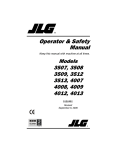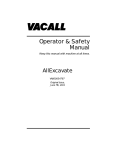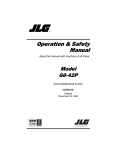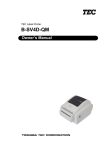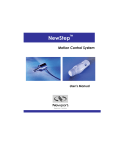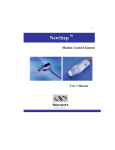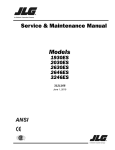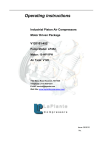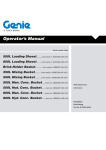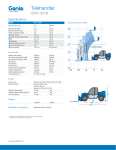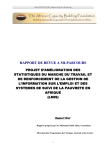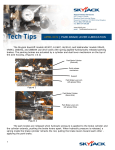Download Operation 31200487
Transcript
Operation & Safety Manual Keep this manual with machine at all times. Suspended Load Supplement for 3509, 3513, 4009, 4013 & 4017 31200487 Revised April 29, 2009 An Oshkosh Corporation Company Revision Log Revision Log REVISION LOG October 23, 2008 - A - Original Issue of Manual April 29, 2009 - B - Revised pages 2-3, 2-4 & 2-5. 31200487 a Read This First Read This First This manual is a very important tool! Keep it with the machine at all times. The purpose of this manual is to provide owners, users, operators, lessors, and lessees with the precautions and operating procedures essential for the safe and proper machine operation for its intended purpose. Due to continuous product improvements, JLG Industries, Inc. reserves the right to make specification changes without prior notification. Contact JLG Industries, Inc. for updated information. Operator Qualifications The operator of the machine must not operate the machine until this manual has been read, training is accomplished and operation of the machine has been completed under the supervision of an experienced and qualified operator. Operation within the U.S.A. requires training per OSHA 1910.178. Operators of this equipment must possess a valid, applicable driver’s license, be in good physical and mental condition, have normal reflexes and reaction time, good vision and depth perception and normal hearing. Operator must not be using medication which could impair abilities nor be under the influence of alcohol or any other intoxicant during the work shift. In addition, the operator must read, understand and comply with instructions contained in the following material furnished with the telehandler: • This Operation & Safety Manual • Telehandler Safety Manual (as required) • All instructional decals and plates • Any optional equipment instructions furnished The operator must also read, understand and comply with all applicable Employer, Industry and Governmental rules, standards and regulations. Modifications Any modification to this machine must be approved by JLG. b 31200487 Read This First This product must comply with all safety related bulletins. Contact JLG Industries, Inc. or the local authorized JLG representative for information regarding safetyrelated bulletins which may have been issued for this product. JLG Industries, Inc. sends safety related bulletins to the owner of record of this machine. Contact JLG Industries, Inc. to ensure that the current owner records are updated and accurate. JLG Industries, Inc. must be notified immediately in all instances where JLG products have been involved in an accident involving bodily injury or death of personnel or when damage has occurred to personal property or the JLG product. FOR: • Accident Reporting and Product Safety Publications • Current Owner Updates • Questions Regarding Product Applications and Safety • Standards and Regulations Compliance Information • Questions Regarding Product Modifications CONTACT: Product Safety and Reliability Department JLG Industries, Inc. 13224 Fountainhead Plaza Hagerstown, MD 21742 USA or Your Local JLG Office (Addresses on back cover) In USA: Toll Free: 1-877-JLG-SAFE (1-877-554-7233) Outside USA: Phone: +1-717-485-6591 E-mail: [email protected] 31200487 c Read This First Other Publications Available For detailed machine operation procedures and safety information, please refer to the appropriate machine Operation & Safety Manual. Note: The following standards may be referenced in this manual: ANSI is compliant to ANSI/ITSDF B56.6 AUS is compliant to AS 1418.19 CE is compliant to EN1459 Refer to the machine Serial Number Plate to identify the applicable compliance standard. d 31200487 Table of Contents Table of Contents TABLE OF CONTENTS Revision Log Read This First Operator Qualifications ...................................................... b Modifications ...................................................................... b Other Publications Available .............................................. d Table of Contents Section 1 - General Safety Practices 1.1 Hazard Classification System ..............................................1-1 Safety Alert System and Safety Signal Words ................1-1 1.2 General Precautions ............................................................1-1 1.3 Operation Safety ..................................................................1-2 Electrical Hazards ...........................................................1-2 Tip Over Hazard..............................................................1-3 Travel Hazard .................................................................1-6 Load Falling Hazard........................................................1-7 Lifting Personnel .............................................................1-8 Driving Hazards on Slopes .............................................1-9 Pinch Points and Crush Hazards ..................................1-10 Fall Hazard....................................................................1-12 Chemical Hazards.........................................................1-13 Section 2 - Load Management Indicator System (LMIS) 2.1 General ................................................................................2-1 2.2 Control Panel .......................................................................2-2 Display ............................................................................2-3 2.3 Operation .............................................................................2-4 System Start Up..............................................................2-4 Attachment Selection ......................................................2-5 Lifting Conditions and Alarms .........................................2-6 2.4 Diagnostic Data ...................................................................2-7 Alarms and Warnings......................................................2-7 LMI Values ......................................................................2-7 Pressure Values..............................................................2-8 Angle and Length Transducers .......................................2-8 LMI Status .......................................................................2-9 31200487 i Table of Contents Section 3 - Machine Operation 3.1 Operating With A Suspended Load..................................... 3-1 Lift Load Safely............................................................... 3-1 Picking Up A Suspended Load....................................... 3-1 Transporting a Suspended Load .................................... 3-2 Leveling Procedure......................................................... 3-2 Placing a Suspended Load............................................. 3-3 Disengaging A Suspended Load .................................... 3-3 Section 4 - Attachments 4.1 Use of the Capacity Chart ................................................... 4-1 Capacity Indicator Locations .......................................... 4-1 Sample Capacity Chart................................................... 4-2 Example.......................................................................... 4-4 Truss Boom .................................................................... 4-5 Section 5 - LMIS Service and Maintenance 5.1 Auto-Diagnostic System ...................................................... 5-1 Alarm Codes................................................................... 5-2 ii 31200487 Section 1 - General Safety Practices SECTION 1 - GENERAL SAFETY PRACTICES 1.1 HAZARD CLASSIFICATION SYSTEM Safety Alert System and Safety Signal Words DANGER OW0010 DANGER indicates an imminently hazardous situation which, if not avoided, will result in death or serious injury. WARNING OW0021 WARNING indicates a potentially hazardous situation which, if not avoided, could result in death or serious injury. CAUTION OW0031 CAUTION indicates a potentiality hazardous situation which, if not avoided, may result in minor or moderate injury. 1.2 GENERAL PRECAUTIONS WARNING Before operation, read & understand this manual. Failure to comply with the safety precautions listed in this manual could result in machine damage, property damage, personal injury or death. 31200487 1-1 Section 1 - General Safety Practices 1.3 OPERATION SAFETY Electrical Hazards 10 FT (3 M) OW0040 • This machine is not insulated and does not provide protection from contact or being near electrical current. • NEVER operate the telehandler in an area where overhead power lines, overhead or underground cables, or other power sources may exist without ensuring the appropriate power or utility company de-energizes the lines. • Always check for power lines before raising the boom. • Follow employer, local and governmental regulations for clearance from powerlines. 1-2 31200487 Section 1 - General Safety Practices Tip Over Hazard General • For additional load requirements, refer to the appropriate capacity chart. OW0050 • Never use an attachment without the appropriate JLG approved capacity chart installed on the telehandler. • Understand how to properly use the capacity charts located in cab. • DO NOT exceed rated lift capacity. • Be sure that the ground conditions are able to support the machine. OW0080 • DO NOT raise boom unless frame is level (0 degrees), unless otherwise noted on capacity chart. 4 FT (1,2 M) OW0100 • DO NOT level machine with boom/attachment above 1,2 m (4 ft). (AUS - DO NOT level machine with load more than 300 mm (11.8 in) above ground surface) 31200487 1-3 Section 1 - General Safety Practices OH2291 • MAINTAIN proper tire pressure at all times. If proper tire pressures are not maintained, this machine could tip over. • Refer to manufacturer’s specifications for proper fill ratio and pressure requirements for tires equipped with ballast. OH20911 • Always wear the seat belt. • Keep head, arms, hands, legs and all other body parts inside operator’s cab at all times. OH2221 If the telehandler starts to tip over: • DO NOT JUMP • BRACE YOURSELF and STAY WITH THE MACHINE • KEEP YOUR SEAT BELT FASTENED • HOLD ON FIRMLY • LEAN AWAY FROM THE POINT OF IMPACT Trying to escape from a tipping machine could result in death or serious injury. 1-4 31200487 Section 1 - General Safety Practices Suspended Load OW0150 • Tether suspended loads to restrict movement. • DO NOT raise the load more than 300 mm (11.8 in) above ground surface or the boom more than 45°. • Weight of all rigging (slings, etc.) must be included as part of load. • Start, travel, turn and stop slowly to prevent load from swinging. • When driving with the boom raised, DO NOT exceed walking speed. • Beware of wind. Wind can cause a suspended load to swing and cause dangerous side loads - even with tag lines. • DO NOT attempt to use telehandler frame-leveling to compensate for load swing. • Keep heavy part of load closest to attachment. • Never drag the load; lift vertically. 31200487 1-5 Section 1 - General Safety Practices Travel Hazard 2-Wheel Front Steer 4-Wheel Circle Steer 4-Wheel Crab Steer OAL2030 • Steering characteristics differ between steer modes. Identify the steer mode settings of the telehandler being operated. • Ensure that adequate clearance is provided between both rear tail swing and front fork swing. • Look out for and avoid other personnel, machinery and vehicles in the area. Use a spotter if you DO NOT have a clear view. • Before moving be sure of a clear path and sound horn. • When driving, retract boom and keep boom/attachment as low as possible while maintaining visibility of mirrors and maximum visibility of path of travel. • Always look in the direction of travel. • Always check boom clearances carefully before driving underneath overhead obstructions. Position attachment/load to clear obstacles. • When driving in high speed, use only front wheel steer (if steering modes are selectable). 1-6 31200487 Section 1 - General Safety Practices Load Falling Hazard OW0130 • Never suspend load from forks or other parts of carriage. • DO NOT burn or drill holes in fork(s). • Forks must be centered under load and spaced apart as far as possible. 31200487 1-7 Section 1 - General Safety Practices Lifting Personnel OW0170 • When lifting personnel, USE ONLY a JLG approved personnel work platform, with proper capacity chart displayed in the cab. OW0190 • DO NOT drive machine from cab when personnel are in platform. 1-8 31200487 Section 1 - General Safety Practices Driving Hazards on Slopes OW0200 To maintain sufficient traction and braking capabilities, travel on slopes as follows: • When unloaded, the rear of the machine is the “heavy end.” Drive with forks pointed downhill. • When loaded, the front of the machine is the “heavy end.” Drive with the forks pointed uphill. • For additional travel requirements, refer to the appropriate capacity chart. • To avoid overspeeding the engine and drivetrain when driving down slopes, downshift to a lower gear and use the service brake as necessary to maintain a slow speed. DO NOT shift into neutral and coast downhill. • Avoid excessively steep slopes or unstable surfaces. To avoid tip over DO NOT drive across excessively steep slopes under any circumstances. • Avoid turning on a slope. Never engage “inching” or shift to “Neutral” when going downhill. • DO NOT park on a slope. 31200487 1-9 Section 1 - General Safety Practices Pinch Points and Crush Hazards Stay clear of pinch points and rotating parts on the telehandler. OW0210 • Stay clear of moving parts while engine is running. OW0220 • Keep clear of steering tires and frame or other objects. OW0230 • Keep clear from under boom. 1-10 31200487 Section 1 - General Safety Practices OW0240 • Keep clear of boom holes. OW0250 • Keep arms and hands clear of attachment tilt cylinder. OW0260 • Keep hands and fingers clear of carriage and forks. OW0960 • Keep others away while operating. 31200487 1-11 Section 1 - General Safety Practices Fall Hazard OW0280 • Enter using the proper hand holds and steps provided. Always maintain 3-point contact when mounting or dismounting. Never grab control levers or steering wheel when mounting or dismounting the machine. • DO NOT get off the machine until the shutdown procedure has been performed. OW0290 • DO NOT carry riders. Riders could fall off machine causing death or serious injury. 1-12 31200487 Section 1 - General Safety Practices Chemical Hazards Exhaust Fumes • DO NOT operate machine in an enclosed area without proper ventilation. • DO NOT operate the machine in hazardous environments unless approved for that purpose by JLG and site owner. Sparks from the electrical system and the engine exhaust can cause an explosion. • If spark arrestors are required, ensure they are in place and in good working order. Flammable Fuel OW0300 • DO NOT fill the fuel tank or service the fuel system near an open flame, sparks or smoking materials. Engine fuel is flammable and can cause a fire and/or explosion. Hydraulic Fluid OW0950 • DO NOT attempt to repair or tighten any hydraulic hoses or fittings while the engine is running or when the hydraulic system is under pressure. • Stop engine and relieve trapped pressure. Fluid in the hydraulic system is under enough pressure that it can penetrate the skin. • DO NOT use your hand to check for leaks. Use a piece of cardboard or paper to search for leaks. Wear gloves to protect hands from spraying fluid. 31200487 1-13 Section 1 - General Safety Practices This Page Intentionally Left Blank 1-14 31200487 Section 2 - Load Management Indicator System (LMIS) SECTION 2 - LOAD MANAGEMENT INDICATOR SYSTEM (LMIS) 2.1 GENERAL The LMIS provides visual indication of stability limitations by monitoring suspended loads compared to predetermined capacity charts. Note: When using non-suspended load type attachments, capacity charts located in the operator cab must be used. Refer to the machine Operation & Safety Manual for details. 31200487 2-1 Section 2 - Load Management Indicator System (LMIS) 2.2 CONTROL PANEL The control panel displays information and allows for the selection of different attachments. 4 3 5 2 1 6 + OZ3091 1. UP Button - Depress to scroll up inside a menu. 2. DOWN Button - Depress to scroll down inside a menu. 3. Display - Shows working data. See page 2-3. 4. Status Lights - Progressively illuminate (two green, yellow then red) to indicate lifting conditions. See page 2-6. 5. ENT Button - Depress to confirm an action. 6. ESC Button - Depress to return to previous menu. 2-2 31200487 Section 2 - Load Management Indicator System (LMIS) Display 1 2 3 4 5 6 0 OFF a c b 0.0 m 0.0 m 0.0 d d OZ3410 0.0 m 0.0 t 7 8 max 0.0 t XXXXX XXXXX 9 10 11 1. Attachment - Current attachment selection (see page 2-5). a. OFF - Select when lifting a non-suspended load. Minimal information shown on display. Capacity charts located in the operator cab must be used. b. Truss Boom attachment selected. 2. Operating Mode c. Outriggers fully engaged. d. Outriggers not engaged. 3. Boom Length - Displays boom length in meters or feet. 4. Bargraph - Displays approximate percentage of rated capacity. 5. Boom Height - Displays boom height in meters or feet. 6. Load Percentage - Displays approximate load percentage of the rated capacity. 7. Load - Displays approximate load in metric ton or k-pounds. Load includes object being lifted and all rigging (slings, etc). 8. Boom Angle - Displays boom angle in degrees. 9. Rated Capacity - Displays rated capacity in metric ton or k-pounds. 10. Reach - Displays boom reach from front of tires in meters or feet. 11. Message Display Window - Displays general system information, alarms and warnings. Note: To change display brightness, depress ESC for 2-3 seconds. As the display cycles through various levels of brightness, depress ENT when the desired brightness is reached. 31200487 2-3 Section 2 - Load Management Indicator System (LMIS) 2.3 OPERATION System Start Up 0 0.0 m 0.0 m 0.0 d 0.0 m OZ3081 0.0 max 0.0 t t 2 1 ST02 Date JLGXXXX 1. When the machine is started the system automatically switches on, performs a self-test and briefly shows the machine model (1) and LMIS software version (2) (dd.mm.yy = software date of development). 0 4 5 0.0 m 0.0 m 0.0 d 0.0 m 0.0 max 0.0 t t OZ3180 2. The display shows the last used attachment icon (4) and current operating mode (5). 2-4 31200487 Section 2 - Load Management Indicator System (LMIS) Attachment Selection The machine can operate with various attachments, but the appropriate capacity chart must be selected by the operator. When an attachment is changed, the LMIS must be manually set to the corresponding attachment capacity chart. 1. Escape out of all menus. 2. Press the UP button. 0 2 3 0.0 m 0.0 m 0.0 d 0.0 m OZ3190 0.0 max 0.0 t t XXXXXXXXXXA XXXX XXXX 1 3. Press the UP or DOWN button until the part number of the attachment capacity chart being used is displayed (1). Note: DO NOT install suspended load type attachments that do not have correct capacity charts available on the LMIS. 4. Confirm the selection by pressing the ENT button. 5. The correct attachment icon (2) should now be displayed. Note: Before lifting a load, check that the correct operating mode (3) is displayed. The system should automatically select the correct operating mode. WARNING Never use a suspended load type attachment without the appropriate JLG supplied capacity chart installed on the LMIS. Failure to use the proper JLG supplied capacity chart could cause a tip over resulting in death or serious injury. 31200487 2-5 Section 2 - Load Management Indicator System (LMIS) Lifting Conditions and Alarms The control panel and external audible beacon tower (if equipped) display machine operating conditions. 1 2 3 4 3 2 0 0.0 m 0.0 m 0.0 d 0.0 m + 0.0 max 0.0 t 1 t - OZ3121 VIEW OF EXTERNAL AUDIBLE BEACON TOWER (IF EQUIPPED) 1. Green Light - Illuminates when load is less than rated capacity. 2. Yellow Light - Illuminates and intermittent alarm sounds when load is approaching rated capacity. 3. Red Light - Illuminates and constant alarm sounds when automatic function cut-out is activated. Certain functions are disabled (i.e. boom lift, extend, etc). Retract boom to re-enable functions. 4. Bargraph - See page 2-3. 5. Automatic Function Cut-Out Override (not illustrated) - Momentarily disables the automatic function cut-out. Indicator flashes while activated. Switch/button and indicator locations vary by model. Refer to the machine Operation & Safety Manual for location details. Note: Override will only function for 30 seconds. After 30 seconds, boom functions will cease and the switch/button will need released and depressed again. WARNING TIP OVER HAZARD. Exceeding lift capacity of the telehandler could damage the equipment and/or cause tip over resulting in death or serious injury. 2-6 31200487 Section 2 - Load Management Indicator System (LMIS) 2.4 DIAGNOSTIC DATA By pressing ENT, the display shows sub-menus. To enter a sub-menu, wait 2-3 seconds on the selected menu. Alarms and Warnings The first menu displays the Alarm and Warning Codes. P01 : Alarms In this menu, the Alarm code and Warning codes are shown. See page 5-2 for listing of codes. Alarms : XXXX Warning : XXXX LMI Values The second menu displays the LMI Values. P02 : Lmi Values In this menu the following values are shown: • P - Differential Pressure (bar). • W - Weight Lifted (ton). • M - Max Load (ton). • Ac - Boom Angle (degree). • L - Boom Length (meter). • R - Boom Radius (meter). P XXX W XXX M XXX Ac XXX L XXX R XXX 31200487 2-7 Section 2 - Load Management Indicator System (LMIS) Pressure Values The third menu displays Pressure Values. P03 : Pressures In this menu the following values are shown: • P - Differential pressure of the Lift cylinder (bar). • L - Pressure in the piston side of the Lift cylinder (bar). • H - Pressure in the rod side of the Lift cylinder (bar). • p - Differential pressure in the Compensation cylinder (bar). • l - Pressure in the piston side of Compensation cylinder (bar). • h - Pressure in rod side of the Compensation cylinder (bar). P XXX L XXX H XXX p XXX l XXX h XXX Angle and Length Transducers The fourth menu displays information from the cable reel. P04 : Act 1A In this menu the following values are shown: • A - Angle Reading from angle sensor. • L - Length Reading from length sensor. • E - Error reading from cable reel. Act1A E : XX 2-8 A : XXX L : XXX 31200487 Section 2 - Load Management Indicator System (LMIS) LMI Status The fifth menu displays information relative to LMI status. P17 : Lmi Status P17 : Lmi Status I 0 : OFF 1. Press ESC to enter the sub-menu. * X I : value 2. Press ESC to move the (*). 3. Press DOWN to decrease the item selected. 4. Press UP to increase the item selected. 31200487 2-9 Section 2 - Load Management Indicator System (LMIS) 2-10 31200487 Section 3 - Machine Operation SECTION 3 - MACHINE OPERATION 3.1 OPERATING WITH A SUSPENDED LOAD Lift Load Safely • You must know the weight and load center of every load you lift. If you are not sure of the weight and load center, check with your supervisor or with the supplier of the material. WARNING TIP OVER HAZARD. Exceeding lift capacity of the telehandler could damage the equipment and/or cause tip over resulting in death or serious injury. • Know the rated load capacities (refer to Section 4 - Attachments) of the telehandler to determine the operating range in which you can safely lift, transport and place a load. Picking Up A Suspended Load • Note the conditions of the terrain. Adjust travel speed and reduce amount of load if conditions warrant. • Avoid lifting double-tiered loads. • Make sure load is clear of any adjacent obstacles. • NEVER operate telehandler without the appropriate JLG supplied capacity chart selected on the LMIS. • Ensure to always properly tether loads to restrict movement. • Refer to “Use of the Capacity Chart” on page 4-1 for proper lifting guidelines in addition to the appropriate capacity chart on the machine. • Only use approved lifting devices rated for the lifting of the load. • Identify the proper lifting points of the load, taking into consideration the center of gravity and load stability. 31200487 3-1 Section 3 - Machine Operation Transporting a Suspended Load OZ3160 OW0130 • Travel in accordance with the requirements set forth in Section 1 - General Safety Practices and Section 4 - Attachments. • For additional requirements, refer to the appropriate capacity chart. Important things to remember: • Ensure the boom is fully retracted. • Never raise the load more than 300 mm (11.8 in) above ground surface or the boom more than 45°. • The combination of side tilt and load could cause the telehandler to tip over. • The guide men and operator must remain in constant communication (verbal or hand) and be in visual contact with the operator at all times. • Never place the guide men between the suspended load and the telehandler. • Only transport the load at walking speed (0.4 m/s) or less. Leveling Procedure 1. Position machine in best location to lift or place load. 2. Apply parking brake and move transmission control lever to NEUTRAL. 3. Move boom so load is no more than 300 mm (11.8 in) above ground surface and/or boom is raised no more than 45°. 4. Observe level indicator to determine whether machine must be leveled prior to lifting load. 3-2 31200487 Section 3 - Machine Operation Placing a Suspended Load Before placing any load be sure that: • The landing point can safely support the weight of the load. • The landing point is level; front to back and side to side. • Use the capacity chart to determine safe boom extension range. See “Use of the Capacity Chart” on page 4-1. • Align load at the level load is to be placed, then position boom slowly until load is just above area where it is to be placed. • Ensure that the guide men and operator remain in constant communication (verbal or hand) when placing the load. Disengaging A Suspended Load • Never place the guide men between the suspended load and the telehandler. • Once at the destination of the load, ensure to bring the telehandler to a complete stop and apply the park brake prior to disengagement of the lifting devices and the tethers. 31200487 3-3 Section 3 - Machine Operation This Page Intentionally Left Blank 3-4 31200487 Section 4 - Attachments SECTION 4 - ATTACHMENTS 4.1 USE OF THE CAPACITY CHART To properly use the capacity chart (see page 4-2), the operator must first determine and/or have the following: 1. A JLG approved attachment. 2. The proper Capacity Chart. 3. Weight of the load being lifted. 4. Load placement information: a. HEIGHT where the load is to be placed. b. DISTANCE from the front tires of the telehandler where the load is to be placed. 5. On the capacity chart, find the line for the height and follow it over to the distance. 6. The number in the load zone where the two cross is the maximum capacity for this lift. If the two cross at a division between zones, the smaller number must be used. 7. For additional operating instructions, refer to the appropriate capacity chart. The number in the load zone must be equal to or greater than the weight of the load to be lifted. Determine the limits of the load zone on the capacity chart and keep within these limits. Capacity Indicator Locations ATTACHMENT IDENTIFICATION PLATE ATTACHMENT CAPACITY PLATE BOOM EXTENSION INDICATOR A LMIS CONTROL PANEL (inside cab) B OZ3400 31200487 4-1 Section 4 - Attachments Sample Capacity Chart This Capacity Chart may be used with this model ONLY. The model of your telehandler is indicated on the boom or chassis. Model XXXX is used for demonstration purposes only. These numbers must match the model/option number stamped on the attachment ID Plate. XXXX P/N XXXXXXXX Travelling Information TRAVELLING (PICK & CARRY) REQUIRES LOAD ON HOOK. MAX TRAVEL WITH RATED LOAD XX M/S. (WALKING SPEED). BOOM FULLY RETRACTED. XXXMM MAX Boom Extension Indicator (arc) XX 70° XX XXXMM MAX G 60° XX F B XX XXXkg XXXkg XX XX LIFTING (STATIONARY) XXXXkg XXXXkg 20° XXXXkg XX XX 10° XX° MAX A 30° XX XX XXXMM MAX C 40° XX XX MAX BOOM ANGLE XX° D XX REQUIRES FIRM SURFACE WITH LOAD ON HOOK. LEVEL CHASSIS BEFORE LIFTING. JIB LEVEL WITHIN ±XX°. X° MAX X° MAX Lifting Information 0° XX m MAX BOOM ANGLE XX° XX° MAX E 50° XX Boom Angle MAX BOOM ANGLE XX° XX° MAX XX X° MAX XX XX XX XX XX XX XX XX XX XX KEEP TRUSS BOOM HORIZONTAL WITHIN ±XX DEGREES. XXXXXXXXXX A TRUSS BOOM ±XX° MAX XX SPECIFICATIONS FOR SAFE USE 1. TYRE SIZES: - XXX/XX-XX XXPLY XX PSI / X BAR. 2. IN-SERVICE WIND SPEED: - XXM/S (XXKM/H). 3. GROUND CONDITIONS: - FIRM SURFACES FOR LIFTING. - SLOPE AND LOAD LISTED ABOVE FOR BOTH CONFIGURATIONS. 4. STANDARD USED: (AS 1418.19-2007). OAM2331 Load zones indicate the maximum weight that may be safely lifted. Specifications for Safe Use Note: This is a sample capacity chart only! DO NOT use this chart, use the one located in your operator cab. WARNING TIP OVER HAZARD. All loads shown on rated capacity chart are based on machine being operated within the parameters indicated on the appropriate capacity chart; proper size tires being properly inflated; and the telehandler being in good operating condition. Failure to comply could result in death or serious injury. 4-2 31200487 Section 4 - Attachments To identify the proper capacity chart on telehandlers equipped with outriggers, refer to the following icons which may be located on the capacity chart. • Use when lifting a load with outriggers up. OW0930 • Use when lifting a load with outriggers down. OW0940 31200487 4-3 Section 4 - Attachments Example A contractor owns a model xxxx telehandler with a truss boom. He knows this attachment may be used with his model since: • The attachment model/option number, matches the attachment number on the capacity chart. • The capacity chart is clearly marked for model xxxx and corresponds with machine configuration being used. • The capacity chart part number is available and selected on the LMIS. Below are examples with various conditions the contractor may encounter and whether or not the load may be lifted. Load Weight Distance Height OK to Lift 1 400 kg (882 lb) 8 m (26.2 ft) 4 m (13.1 ft) Yes 2 1000 kg (2,205 lb) 6 m (19.7 ft) 9 m (29.5 ft) NO 3 1500 kg (3,307 lb) 4 m (13.1 ft) 6 m (19.7 ft) Yes 4 1250 kg (2,756 lb) 5 m (16.4 ft) 11 m (36.1 ft) NO XXXX P/N XXXXXXXX 14 70° 13 G 60° 12 E D 10 C 40° 9 B 8 A 30° 7 20° 2 1 Example 3 250kg 3 10° 500kg 4 1.000kg 5 1.500kg 6 2.000kg Example 2 Example 1 Example 4 F 50° 11 0° 0 m 11 10 9 8 7 6 5 4 3 2 1 0 OAM2321 Note: This is a sample capacity chart only! DO NOT use this chart, use the one located in your operator cab. 4-4 31200487 Section 4 - Attachments Truss Boom Description P/N Truss Boom 2 m - 4000 kg.........................................1001101442 OZ3420 Use Truss Boom Capacity Chart Suspend loads in accordance with requirements set forth in Section 1 - General Safety Practices. The joystick (1) controls movement of the boom. The attachment tilt roller switch (2) controls truss boom tilt. • Push roller switch down to tilt up. • Push roller switch up to tilt down. 31200487 4-5 Section 4 - Attachments This Page Intentionally Left Blank 4-6 31200487 Section 5 - LMIS Service and Maintenance SECTION 5 - LMIS SERVICE AND MAINTENANCE 5.1 AUTO-DIAGNOSTIC SYSTEM The LMIS is equipped with an auto-diagnostic system which is able to detect faulty pressure transducers, boom angle/length sensors, broken cables or internal electronic faults. When the alarm sounds, the display shows an alarm message. If an alarm code sounds apply the park brake, shift the transmission into “Neutral”, lower forks or attachment to the ground and shut off the engine. Restart the engine. If the alarm code persists, refer to “Alarm Codes” on page 5-2. For troubleshooting information, refer to the appropriate machine service manual. For additional information, contact your local authorized service distributor. 31200487 5-1 Section 5 - LMIS Service and Maintenance Alarm Codes Alarm Code Description 1 Memory Data Not Reliable 2 Angle Sensor 1 reading lower than minimum value 3 Angle Sensor 1 reading higher than maximum value 4 Reading of boom length sensor 1 lower than minimum value 5 Reading of boom length sensor 1 higher than maximum value 10 Reading pressure of Lift cylinder (bottom side) lower than minimum value 11 Reading pressure of the Lift cylinder (bottom side) higher than maximum value 12 Reading pressure of the Lift cylinder (rod side) lower than minimum value 13 Reading pressure of the Lift cylinder (rod side) higher than maximum value 14 Reading pressure of the Compensation cylinder (bottom side) lower than minimum value 15 Reading pressure of the Compensation cylinder (bottom side) higher than maximum value 16 Reading pressure of the Compensation cylinder (rod side) lower than minimum value 17 Reading pressure of the Compensation cylinder (rod side) higher than maximum value 120 Canbus time-out from cable reel 121 Internal error from cable reel 5-2 31200487 An Oshkosh Corporation Company JLG Industries, Inc. 1 JLG Drive McConnellsburg PA. 17233-9533 USA Phone: +1-717-485-5161 Customer Support Toll Free: 1-877-554-5438 Fax: +1-717-485-6417 JLG Worldwide Locations JLG Industries (Australia) P.O. Box 5119 11 Bolwarra Road Port Macquarie N.S.W. 2444 Australia Phone: +61 265 811 111 Fax: +61 265 810 122 JLG Latino Americana Ltda. Rua Eng. Carlos Stevenson, 80-Suite 71 13092-310 Campinas-SP Brazil Phone: +55 193 295 0407 Fax: +55 193 295 1025 JLG Industries (UK) Ltd Bentley House Bentley Avenue Middleton Greater Manchester M24 2GP England Phone: +44 (0)161 654 1000 Fax: +44 (0)161 654 1001 JLG France SAS Z.I. de Baulieu 47400 Fauillet France Phone: +33 (0)5 53 88 31 70 Fax: +33 (0)5 53 88 31 79 JLG Deutschland GmbH Max-Planck-Str. 21 D - 27721 Ritterhude-lhlpohl Germany Phone: +49 (0)421 69 350 20 Fax: +49 (0)421 69 350 45 JLG Equipment Services Ltd. Rm 1107 Landmark North 39 Lung Sum Avenue Sheung Shui N.T. Hong Kong Phone: +852 2639 5783 Fax: +852 2639 5797 JLG Industries (Italia) s.r.l. Via Po. 22 20010 Pregnana Milanese - MI Italy Phone: +39 029 359 5210 Fax: +39 029 359 5845 JLG Europe B.V. Polaris Avenue 63 2132 JH Hoofddorp The Netherlands Phone: +31 (0)23 565 5665 Fax: +31 (0)23 557 2493 JLG Polska UI. Krolewska 00-060 Warsawa Poland Phone: +48 (0)914 320 245 Fax: +48 (0)914 358 200 JLG Industries (Scotland) Wright Business Centre 1 Lonmay Road Queenslie, Glasgow G33 4EL Scotland Phone: +44 (0)141 781 6700 Fax: +44 (0)141 773 1907 Plataformas Elevadoras JLG Iberica, S.L. Trapadella, 2 P.I. Castellbisbal Sur 08755Castellbisbal, Barcelona Spain Phone: +34 93 772 4 700 Fax: +34 93 771 1762 JLG Sverige AB Enkopingsvagen 150 Box 704 SE - 176 27 Jarfalla Sweden Phone: +46 (0)850 659 500 Fax: +46 (0)850 659 534














































